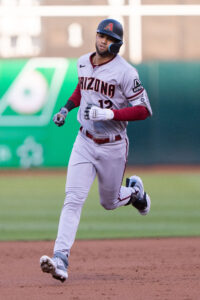In an offseason light on impact trade activity, the Diamondbacks and Blue Jays pulled off one of the biggest swaps. Arizona’s left-handed hitting outfield surplus and Toronto’s catching depth materialized in the deal that sent Gold Glove caliber outfielder Daulton Varsho to Toronto for rookie backstop Gabriel Moreno. That duo were the main players involved, but Arizona also added right-handed balance to the lineup with the inclusion of veteran left fielder Lourdes Gurriel Jr.
Gurriel has a longer MLB track record than either of Varsho or Moreno but was by far the tertiary player in terms of trade value. He’d been a good but not elite hitter throughout his time with the Jays. In 2022, the Cuban-born outfielder put up a .291/.343/.400 batting line with five home runs over 493 plate appearances. That offensive output checked in 14 percentage points above league average by measure of wRC+. Paired with average defensive marks in a corner outfield spot, Gurriel has been worth between one and two wins above replacement in every season of his career (although he would’ve been on a better pace in 2020 if that schedule hadn’t been truncated).
There was no question Gurriel was a viable major league player. He’d been a near average regular for the entirety of his career. Due roughly $5.4MM in his final season before free agency — a clause in the contract he signed with Toronto after defecting from Cuba allows him to reach the open market next winter even though he’ll be a little shy of six years of MLB service — he had trade value but not an overwhelming amount.
Arizona anticipated an immediate downgrade in their outfield from Varsho to Gurriel, a tradeoff they were willing to make to install Moreno behind the plate for the next six seasons. While that could still play out, Gurriel has somewhat surprisingly been the far more productive of the two outfielders through the first couple months of the year. Varsho has started his Toronto tenure with a .217/.294/.382 showing through 42 contests. Over his first 39 games in the desert, Gurriel is off to a career-best .310/.373/.552 pace. His seven homers in 161 plate appearances already tops last year’s mark and puts him on pace to beat his career-best 21 longballs from two years ago.
As MLBTR’s Mark Polishuk explored before this season, injuries could certainly have played a role in Gurriel’s up-and-down results from 2022. He’d bookended a very strong run between June and July with dismal numbers in May and August. A hamstring strain cut his season short in early September and, likely of greater import on his production, he underwent surgery on the hamate bone in his left hand following the season. Hand and wrist injuries can sap a hitter’s strength; if Gurriel were playing through that issue for a while, it’d be understandable why his power production was at a career-worst level.
Better health is a plausible explanation for some of Gurriel’s improved production but doesn’t account for all of it. He’s also working with a more dialed-in plate approach than he has in years past. Through play Wednesday, he’s sitting on a personal-low 14.9% strikeout rate and drawing walks at a career-best 8.1% clip.
While Gurriel has always had good bat-t0-ball skills, he has taken things to a new level in the early going by being more selective. He has offered at 45.8% of the pitches he’s seen, the lowest rate of his career by three percentage points. Gurriel is translating that approach into consistent contact. He has gotten the bat on the ball on an excellent 85.8% of his swings, almost six points better than last year’s personal-high mark. Pitchers have been unable to beat him in the zone, with Gurriel making contact nearly 92% of the time he goes after a would-be strike. He’s putting the ball in play more consistently without sacrificing any of his contact authority.
That’s an ideal combination for a hitter. Gurriel is 29th among 171 qualified batters in on-base percentage and 10th in slugging. That plays even without elite defense in the outfield. It’s among the reasons Arizona sits at 25-19 with a +16 run differential and looks like a legitimate contender for a Wild Card spot in an uncertain National League playoff picture.
A career showing couldn’t be timed better for Gurriel personally. He’s headed to the open market for the first time since he was a 23-year-old amateur signee. He’ll do so in advance of his age-30 season and as part of a free agent class that looks very thin on position player talent. Among potential impending free agents with 100+ plate appearances, only Matt Chapman, Kevin Kiermaier and Max Muncy (who’s controllable for 2024 via $10MM club option) have a higher wRC+ than Gurriel’s 148.
Gurriel isn’t going to be the #3 free agent position player in the class but he has a chance to hit his way into a solid multi-year deal. Mitch Haniger and Michael Conforto topped $35MM on contracts with opt-out possibilities as bat-first corner outfielders. Both players had durability concerns that aren’t there with Gurriel. The five years and $75MM secured by Andrew Benintendi feels lofty given Benintendi’s defensive advantage and youth (he signed going into his age-28 season), but Gurriel looks like the superior hitter.
At the very least, Arizona’s new acquisition has a chance to position himself as an interesting mid-tier free agent. It remains to be seen if he can keep up his present pace over six months but he looks healthier than he had last season and is making excellent swing decisions. It’s a better start than the D-Backs could’ve expected and a key development in the club’s strong start to the year.
Image courtesy of USA Today Sports.

